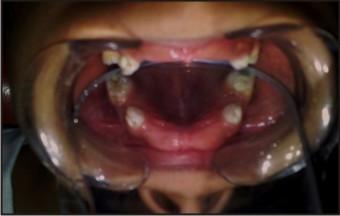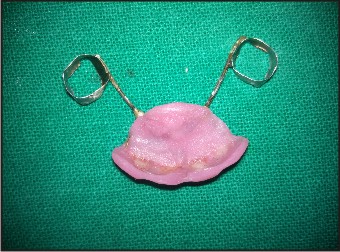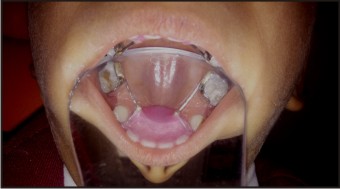Introduction
There are many morphogenetic and environmental influences, which effect the occlusal development, and a disorder or deviation in any of these elements may influence the occlusion. The permanent teeth dislocation occurs in the eruptive, pre functional and functional periods of the eruption, i.e. within the primary arch and in the mixed dentition stage. [1] Premature loss of primary posterior teeth leads to mesial migration or tipping of the adjacent tooth, which can be permanent first molar or deciduous second molar into the space. This leads to loss of arch length, thus affecting the structural balance and functional efficiency by causing crowding or ectopic eruption and even impaction of permanent teeth[2]. This necessitates the preservation of arch length by means of space maintainers to prevent the need of complex orthodontic treatment at a later stage.
Space loss, generally does not occur in the anterior segment if primary canines are present in the occlusion. But loss of anterior teeth, on the other hand, acts as a major setback for the growing patient because of the aesthetic reasons. It can lead to mocking by peer groups in school, causing psychological trauma to the growing child. Development of deleterious habits like tongue thrusting, forward resting posture of the tongue is also a concern following premature loss of anterior teeth.[1] It also has impact on speech development and the ability to articulate certain speech sounds, thus effecting the overall personality of the growing child.[3] All these factors necessitate the replacement of the anterior teeth by an appliance that satisfies the aesthetics and functional needs.
An anterior removable appliance incorporating artificial teeth satisfy aesthetic requirements of the young patients, but when considered the factors like cooperation in wear, comfort, appliance loss or damage, such removable appliance are problematic.Fixed appliances, on the other hand, if properly designed, are less damaging to the oral tissues and less of an annoyance to the paediatric patient thereby ensuring compliance and longevity of wear.[4]
Traditionally, the treatment of choice for premature and bilateral maxillary posterior teeth loss is the placement of a Nance appliance. It was first described by Nance in 1947, and it is very popularly in pediatric dentistry even today. The appliance is cemented with bands placed on the molar teeth and a palatal acrylic button placed in the region of the rugae palatinae in the anterior part of the palate. The bands are connected to the button using a 0.9 mm round stainless steel wire. The acrylic button, which is up against the palatal mucosa, provides support derived from the hard palate.[5]However, when there is premature loss of multiple posterior teeth occur in one segment, we can use transpalatal arch space maintainer, because the loss of space in the upper arch takes place in mesiopalatal direction.
In this case report, we present the modification of traditional Nance Appliance, where acrylic teeth were incorporated in the anterior part of the appliance, for a patient with missing maxillary incisors and first molars bilaterally. The modified design met the patients’ need for a space maintainer in the posterior segment and a fixed prosthesis replacing maxillary incisors in the anterior segment. Additional stabilization of the anterior part of the appliance was obtained by adding a framework of stainless steel wire which was acrylized adding the teeth.
Case Report
A 5 year old boy reported to with missing maxillary incisors and both the first molars (Fig.1). The parents gave a history of caries associated with the teeth for which extractions were performed at a private clinic. From the history given by parents, it was concluded that the patient had severe early childhood caries, so the dentist performed extractions of the involved teeth. The parents wanted the restoration of the involved teeth and replacement of the anterior teeth.
 | Figure 1- Intra-oral view of missing primary maxillary central incisors and primary maxillary molars.
 |
The option of placement of modified Nance Palatal Arch was discussed and consent was obtained from the parents. During the first visit, molar bands were fabricated on the deciduous right and left maxillary second molars. A full mouth alginate impression with bands in place was made for maxillary arch. Mandibular impression was also made and wax bite registration was done.
Under laboratory procedures, stone models were cast from the impressions. With 19 gauge stainless steel wire, a Nance palatal arch was made and the wire lay passively against the anteroinferior aspect of the palate. The distal end of the wire rested in contact with the palatal surface of the maxillary molar bands and was soldered. An additional wire framework, made of 21 gauge wire was soldered on the anterior aspect of the standard Nance framework which extended from mesial of one canine to the labial surface of the maxillary ridge to the mesial of the other canine. The bite registration was done to maintain the vertical and anteroposterior relations of jaws and teeth. The metal framework was waxed up with teeth and routine procedures were carried out. The appliance was removed after heat curing the acrylic followed by finishing and polishing.(Fig. 2a,b).
 | Figure 2 (a) Fabricated modified nance palatal arch.
 |
 | Figure 2 (b)- Fabricated modified nance palatal arch.
 |
On the next appointment, try-in of the appliance and occlusal adjustments were done. All the carious teeth were restored. Finally, the finished appliance was cemented using the Glass Ionomer Cement. Prior to discharge of the patient, instructions were given regarding oral hygiene maintenance and consumption of soft diet for first few hours.(Fig.3) The patient was recalled after one week to check any impingement of the appliance and the parents were instructed to report to the clinic after six months.
 | Figure 3- Occlusal view of modified nance palatal arch in situ.
 |
Both the patient and the parents were satisfied with the treatment and the aesthetics.(Fig.4).
 | Figure 4- Intraoral view of the appliance after positive adaptation to the child.
 |
Discussion:
Despite of advances in dental sciences, in methods of caries prevention and promotion of oral health globally, early primary tooth loss continues to affect many children. The prevalence of early primary tooth loss has been estimated to be as high as 28.9%, with a range of 4.3 to 42.6%. [6] The premature loss of primary teeth due to caries, trauma, ectopic eruption, or other causes may lead to undesirable tooth movements of primary and/or permanent teeth including loss of arch length.[7] Jytte Pedersenet al, 2006 reported that early loss of primary teeth would result in an increased frequency of sagittal, vertical as well as transversal malocclusion. Hence, wherever possible, restoration of the natural primary tooth should be attempted but in case of extraction or avulsion of the natural tooth, maintenance of the space to guide the eruption of permanent tooth is mandated.
Developmental stage of occlusion, as well as differences in maxillary and mandibular arches are important factors to be considered while space management. When the loss of primary tooth occurs close to the physiological age of exfoliation, premature eruption of the permanent successor occurs.
However, when the loss of primary tooth occurs when the root has just started forming, bone neoforms over permanent tooth germ which could result in delayed eruption, mandating the need of space maintenance.[6] Radiographs can be used to detect the amount of bone covering the permanent tooth bud and it usually takes 4 to 6 months by an erupting tooth to move through 1mm of bone. Moreover, teeth erupting adjacent to the edentulous area have a greater effect on the amount of space lost than do fully erupted teeth.[1]
The loss of space is more in premature loss of second primary molar than the first primary molar, with greater mesialization of the permanent first molar occurring during its active eruption phase. However, in case of loss of deciduous first molar, there is greater distalization of canine into the available space than mesialization of the adjoining tooth into the space and extending the changes to as far as the midline. The loss of space is more in children having deleterious habits like thumbsucking, tongue thrusting, mouth breathing etc.[8]
Most of the space loss occurs during the first 6 months of the loss of deciduous tooth, with space closure occurring more rapidly in maxillary arch than the mandibular arch. Also, when mandibular permanent molars move anteriorly, they show only mesial tipping into the available space leading to loss of space whereas the permanent maxillary molars rotate mesiopalatally around the large palatal root which acts as a pivot causing rotation as well as bodily movement. Hence, contributing to greater loss of space in maxilla than in the mandible. This makes the use of holding appliance inevitable to maintain the position of the teeth. In case of unilateral loss of maxillary first and second molars, transpalatal arch may be givenas it reduces anterior molar movement by coupling the right and left permanent molars together and, thus, preventing any possibility of rotations.[2] Bilateral loss of both the primary molars indicate the use of Nance palatal arch and lingual holding arch in maxilla and mandible respectively.
Anterior dental disharmonies especially interfere with the normal tongue placement which then can lead to the development of maladaptive articulatory habits. Tongue thrust commonly develops when prematurely lost deciduous anterior teeth are not replaced.Yet another consideration is the child’s speech development following extraction of all four incisors. Many sounds are made with the tongue touching the lingual side of the maxillary incisors and inappropriate speech compensations can develop if the teeth are missing.[3]
Removable or fixed prosthesis can be used to replace deciduous anterior teeth in children that have been prematurely lost due to disease.[9] Modification of Nance appliance with acrylic teeth in the anterior part, meets the need of a posterior space maintainer and anterior fixed prosthesis in a young child. It serves as an interim appliance in children with premature loss of anterior teeth.Despite its short-term usage, it aids to improve speech and esthetics, and prevent psychological disturbances and tongue thrust habits. It is cemented into position and requires minimal post insertion adjustments.
No space maintainer, with the exception of the primary tooth can fulfill all the requirements of an ideal appliance, including preservation of space, eruption of adjacent, succedaneous, and abutment teeth, restoration of masticatory function, prevention of overeruption of antagonists, compatibility with soft tissues and effective hindrance of torquing forces on abutment teeth. But an attempt was made to meet the aesthetic demands while preventing the space loss with this new innovative appliance.[10]
Conclusion:
Early loss of primary teeth continues to be highly prevalent in India due to bottle feeding habit, lack of knowledge of proper oral hygiene maintenance, abnormal food habits leading to malocclusion in developing permanent dentition. A continuous and meticulous treatment planning is essential to monitor space loss and eruption of permanent teeth to prevent malocclusion.
References:
1. Heilborn J.C, Kuchler E.C, Fidalgo T.K.S, Antines L.A.A, Costa M.C.- Early primary tooth loss: prevalence, consequence and treatment. Int J Dent, Recife, 10(3) 126-130.
2. Kupietzky .A, Eli Tal- The transpalatal Arch: An alternative to the nance appliance for space maintainers. Pediatric dentistry, May/June 07, Vol. 29(3): 235-238.
3. Turgut M.D, Genc G.A, Basar F, Tekcicek M.U- The effect of early loss of anterior primary tooth on speech production in preschool children. Turk J. Med Sci 2012; 42(5): 867-875.
4. Klapper B.J, Sherwin R.S- Esthetic anterior space maintenance. Pediatric dentistry, AAPD vol.5(2):121-123.
5. Singh Paramjit and Cox Shirley- Nance Palatal arch: a cautionary tale. Journal of Orthodontics, 2009; vol.36 : 272-276.
6. Rickman G.A, El-Badrawy H.E- Effect of premature loss of primary maxillary incisors on speech. Pediatric dentistry, June 1985; Vol. 7(2):119-122.
7. Guideline on management of the developing dentition and occlusion in Pediatric dentistry. American academy of Pediatric dentistry, reference manual vol 36(6): 14-15.
8. Dawjee S.M, Khan M.I, Hlongwa P- The repositioning nance appliance : a fixed functional appliance and case report. J Maxillofac Oral Surg 8(1): 68-73.
9. Stivaros N, Lowe C, Dandy N, Doherty B and Mandall N.A- A randomized clinical trial to compare the Goshgarian and nance palatal arch. European Journal of Orthodontics 32 (2010) 171-176.
10. Wilson .B, Joseph .J, Bharadwaj P, Kaushik P.C- Space management in Paediatric dentistry. The journal of dental Panacea 2014, oct-nov,Vol 1(2).
11. Rapp R, Demiroz I – A new design for space maintainers replacing prematurely lost first primary molars. Pediatric dentistry, American academy of Pedodontics vol.5 (2): 131-134.
12. Ngan .P, Alkire R.G, Fields. H- Management of space problems in the primary and mixed dentitions. JADA ,Sept. 1999 vol 130: 1331-1339.
13. Kupietzky .A- The treatment and long term management of several multiple avulsions of primary teeth in a 19-month old child. AAPD 2001; 25(6): 517-521.
14. Guideline on Pediatric restorative dentistry. AAPD,1991.
15. Faheemuddin M, Yazdanie N, Nawaz M.S- A simple and quick technique of fabricating a space maintainer for avulsed primary maxillary incisors. Pakistan Oral and Dental journal (Aug 2012), vol 32(2).
16. Prabhakar M, Kaur Mauli Simrit- Prosthetic replacement options for premature loss of deciduous anterior teeth. Indian journal of dental sciences, October 2014, vol 6(4).
17. Willet R.C- Premature loss of deciduous teeth. Chicago association of orthodontics, Jan 23, 1933.
18. Dr. Mohammad Khursheed Alam- A toZ orthodontics, vol.9.
|